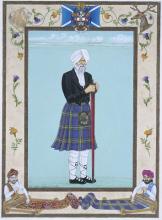Scotland might be known for many things such as whiskey, bagpipes, and haggis. But post-Braveheart, the country has primarily become synonymous with one thing. Kilts. The Scottish kilt is the traditional dress worn by the Highlanders and is a skirt-like garment wrapped around the wearer's waist and extending down to the middle of the knees. Its fame arises not just from the curious picture of brawny men wearing skirts, but from the fact that it is traditionally brawny men wearing skirts sans underwear.
Kilts are mostly made out of varieties of woollen fabrics and customarily sport different patterns of design known as tartan. Each tartan pattern is associated with a particular Scottish clan. These designs are identifiable through their peculiar criss-cross bands of colour and are unique to each clan. Recently, Sikh immigrants to the country have commissioned their own tartan pattern to identify their community. The Sikh tartan was introduced in 2000 and is woven into kilts, ties and other uniforms. The design is based on the traditional colours of Sikhism - orange and navy blue - together with the green and saffron of the Indian flag. The basic pattern is based on the Campbell tartan worn by Sikhs in the British Army.
The birth of the 'Singh Tartan' is attributed to Lord Iqbal Singh, a wealthy Sikh businessman, who wanted to give his community an identity similar to the other clans of Scotland such as the MacMillans and the MacKenzies.

